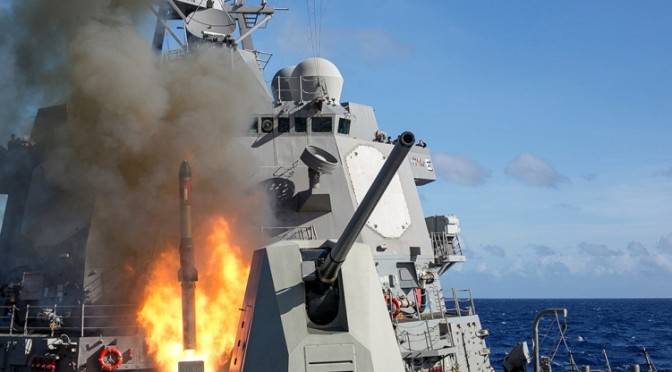William Selby is a Marine Officer who previously completed studies at the US Naval Academy and MIT researching robotics. The views and opinions expressed in this article are his own.
In September 1999, NASA lost a $125 million Mars orbiter because a contracted engineering team used English units of measurement while NASA’s team used the metric system for a key spacecraft operation.[i] In everyday life we are forced to choose between differing formats with the same function. What was once VHS vs. Betamax became Blu-ray vs. HD DVD. A lack of component standardization can reduce the operational effectiveness of a system as shown by the NASA orbiter. More commonly, the end user may waste resources purchasing multiple components that serve the same purpose, as was the case for DVD players in the late 2000s. These same issues are occurring in the development, procurement, and operation of our unmanned systems. Over the last decade, the US military has amassed large numbers of unmanned systems composed of highly proprietary hardware and software components. However, future unmanned systems designed with interoperable hardware and software and constructed utilizing advanced manufacturing techniques will operate more effectively and efficiently than today’s platforms.
Advances in manufacturing techniques as well as efforts to standardize software and hardware development are being pursued in order to diminish the negative effects caused by proprietary components in unmanned systems. These new technologies focus on speed and customization, creating a new and evolving research, development, and production methodology. Modular designs increase the rate of production and upgrades while new manufacturing techniques enable rapid prototyping and fabrication on the front lines. Replacement parts can be stored digitally, produced on demand, and swapped between unmanned systems, reducing the system’s logistical footprint. This organic production capability will enable units to tailor manufacturing needs to match operational requirements. The resulting unmanned systems will operate with interchangeable payloads making them quick to adapt to a dynamic environment while common software will enable easier control of the vehicles and wider data dissemination.
Complementary Technologies
The concept of interoperable hardware and software is more formally referred to as open architecture (OA). DOD Directive 5000.1, “The Defense Acquisition System,” outlines the DOD’s goal to acquire systems that can be easily swapped between unmanned systems similar to the way different types of USB devices can be swapped out on a personal computer. [ii] This ranges from swapping sensor payloads between platforms to entire unmanned systems between services and countries.[iii] Establishing standards and creating policy for OA are the responsibilities of multiple organizations. For unmanned aerial systems (UASs), the Interoperability Integrated Product Team (I-IPT) drafts UAS System Interoperability Profiles (USIPs). Similarly, the Robotic Systems Joint Program Office (RS JPO) creates Interoperability Profiles (IOPs) to identify and define interoperability standards for unmanned ground systems. Several of the IOP standards have been adopted for unmanned maritime systems by the Naval Undersea Warfare Center.[iv]
Advances in manufacturing techniques complement and leverage the OA concept. In general, these techniques focus on converting a digital blueprint of a component into its physical form. The advantages of additive manufacturing, commonly known as 3D printing, have been recently publicized as well as potential military applications.[v],[vi],[vii],[viii] 3D printing creates the desired object in metal or plastic by converting liquid or powdered raw materials into a thin solid layer, forming a single layer at a time until the piece is completed. Less mature technologies include Printed Circuit Microelectromechanical Systems (PC-MEMS) uses 3D printing to create a flat object of rigid and flexible materials with special joints that are later activated turning the flat object into a three-dimensional object much like a children’s pop up book. [ix],[x] A final technique inspired by origami involves etching crease patterns into flat sheets of metal allowing them to be quickly folded and assembled into complex components. [xi]
Lifecycle Impacts
Production of future unmanned systems will be altered by these technologies beginning with the initial system requirements.[xii] Standard capability descriptors minimize the need for a single, large business to create and entire unmanned system. This will allow small businesses to focus research and development on a single capability that can be integrated into multiple platforms requiring that capability thereby increasing competition and innovation while reducing initial procurement costs.[xiii],[xiv] These unmanned systems will be easily upgradeable since payloads, sensors, and software are anticipated to evolve much faster than the base platforms.[xv] Open hardware and software ensures that upgrades can be designed knowing the component will function successfully across multiple platforms. Advanced manufacturing techniques will enhance the development of these upgrades by allowing companies to rapidly prototype system components for immediate testing and modification. Companies can digitally simulate their component to verify their design before mass producing a final version with more cost effective traditional manufacturing techniques. The final version can then be digitally distributed enabling the end user to quickly load the most recent version before production.
These technologies also have the potential to significantly impact supply chain management and maintenance procedures required for unmanned systems. Since components can be swapped across multiple platforms, it will no longer be necessary to maintain independent stocks of proprietary components unique to each platform. If a component can be created using organic advanced manufacturing techniques, only the digital blueprint and raw materials need to be available. While the strength of components created using additive manufacturing may not be enough for a permanent replacement, temporary spare parts can be created in a remote area without quick access to supplies or depot repair facilities while permanent replacements are delivered. This reduces the logistical footprint and maintenance costs by limiting the number of parts and raw materials required to be physically stored for each system.
Most importantly, these technologies will produce unmanned systems with the operational flexibility necessary for the unknown conflicts of the future. Components ranging from power systems to sensor payloads can be quickly and easily swapped between platforms of varying vendors, selected to fit the mission requirements and replaced as the situation develops.[xvi]Standardizing the sensor’s data transmission format and metadata will generate timely and accurate data that is more easily accessed and navigated by all interested parties.[xvii] An early example of these advancements, the Army’s One System Remote Video Terminal, allows the user to receive real time video footage from multiple platform types as well as control the sensor payload.[xviii],[xix] Digital libraries will close the gap between developer and user ensuring the most recent component design is manufactured or the latest software capability is downloaded and transferred across platforms.[xx] Standardized communications protocols between the platform and the controller will enable a single controller to operate different platforms, as recently demonstrated by the Office of Naval Research.[xxi] Further into the future, the operator may be able to control multiple unmanned systems across various domain simultaneously.[xxii],[xxiii] The ability to create heterogeneous “swarms” of unmanned systems with varying sensor suites in different physical operating environments will give the commander the flexibility to quickly configure and re-configure the unmanned system support throughout the duration of the operation.
New Technologies Create New Vulnerabilities
As these technologies are implemented, it is important to keep in mind their unique limitations and vulnerabilities. The stringent qualification process for military components, especially those with the potential to harm someone, is often described a key limitation to the implementation of modular components.[xxiv] However, without people on board, unmanned systems have lower safety standards making it easier to implement modular components in final designs. Compared to traditional methods, additive manufacturing is slow and produces parts limited in size. The materials have limited strength and can be 50 to 100 times more expensive than materials used in traditional methods.[xxv] While future development will decrease prices and increase material strength, traditional manufacturing techniques will remain more cost effective means of producing high volume items into the near future. Additionally, open designs and digital storage can create vulnerabilities that may be exploited if not properly secured. Militants in Iraq purportedly viewed live video feeds from UASs using cheap commercial software while Chinese cyberspies allegedly gained access to many of the US’s advanced weapons systems designs.[xxvi],[xxvii] Further, digital blueprints of parts have the potential to be modified by nefarious actors to create counterfeit or falsified parts.[xxviii] As the price of manufacturing equipment quickly drops, anyone can create the products when given access to the digital copies.[xxix]
Future technological innovations have the ability to modify traditional supply methodologies allowing the end user to manufacture parts on demand for use in a variety of unmanned systems. Proprietary hardware and software can be minimized, resulting in unmanned systems with smaller logistical footprints condensing vulnerable supply chains while reducing overall system cost. These benefits are tempered by the unique vulnerabilities that arise when standardizing and digitizing unmanned system designs. Despite these potential vulnerabilities, the ability to equip a force with increased capability while reducing costs and logistical requirements is indispensable. While the locations of the next conflicts will remain hard to predict, unmanned systems able to complete a variety of missions in remote areas with limited logistical support will become an operational necessity.
[i] Lloyd, Robin, Metric mishap caused loss of NASA orbiter, accessed athttp://www.cnn.com/TECH/space/9909/30/mars.metric.02/index.html?_s=PM:TECH, 30 September 1999.
[ii] U.S. Department of Defense, DOD Directive 5000.1 – The Defense Acquisition System, Washington D.C., 12 May 2003.
[iii] U.S. Department of Defense, Unmanned Systems Integrated Roadmap FY2013-2038, Washington D.C., 2013.
[iv] U.S. Department of Defense, Unmanned Systems Integrated Roadmap FY2013-2038, Washington D.C., 2013.
[v] Llenza, Michael, “Print when ready, Gridley,” Armed Forces Journal, May 2013.
[vi] Beckhusen, Robert, Need Ships? Try a 3-D Printed Navy, accessed at http://www.wired.com/dangerroom/2013/04/3d-printed-navy/, 04 May 2013.
[vii] Cheney-Peters, Scott and Matthew Hipple, “Print Me a Cruiser!” USNI Proceedings, vol. 139, April 2013.
[viii] Beckhusen, Robert, In Tomorrow’s Wars, Battles Will Be Fought With a 3-D Printer, accessed at http://www.wired.com/dangerroom/2013/05/military-3d-printers/, 17 May 2013.
[ix] Leung, Isaac, All abuzz over small pop-up machines with Printed Circuit MEMS, accessed at http://www.electronicsnews.com.au/news/all-abuzz-over-small-pop-up-machines-with-printed-, 22 February 2012.
[x] Wood, R.J., “The First Takeoff of a Biologically Inspired At-Scale Robotic Insect,” Robotics, IEEE Transactions on , vol.24, no.2, pp.341,347, April 2008.
[xi] Soltero, D.E.; Julian, B.J.; Onal, C.D.; Rus, D., “A lightweight modular 12-DOF print-and-fold hexapod,” Intelligent Robots and Systems (IROS), 2013 IEEE/RSJ International Conference on , vol., no., pp.1465,1471, 3-7 Nov. 2013.
[xii] U.S. Department of Defense, Unmanned Systems Integrated Roadmap FY2011-2036, Washington D.C., 18 September 2012.
[xiii] Real-Time Innovations, Interoperable Open Architecture, accessed at
http://www.rti.com/industries/open-architecture.html, 2012.
[xiv] U.S. Department of Defense, Unmanned Systems Integrated Roadmap FY2013-2038, Washington D.C., 2013.
[xv] U.S. Department of Defense, Unmanned Systems Integrated Roadmap FY2013-2038, Washington D.C., 2013.
[xvi] Real-Time Innovations, Interoperable Open Architecture, accessed at
http://www.rti.com/industries/open-architecture.html, 2012.
[xvii] Crawford, Katherine, ONR Provides Blueprint for Controlling All Military Unmanned Systems, accessed at http://www.onr.navy.mil/Media-Center/Press-Releases/2013/ONR-Provides-Blueprint-for-Controlling-UAVs.aspx, 01 May 2013.
[xviii] Shelton, Marty, Manned Unmanned Systems Integration: Mission accomplished, accessed at http://www.army.mil/article/67838, 24 October 2011.
[xix] AAI Corporation, One System Remote Video Terminal, accessed at https://www.aaicorp.com/sites/default/files/datasheets/OSRVT_07-14-11u.pdf, 14 July 2011.
[xx] Lundquist, Edward, DoD’s Systems Control Services (UAS) developing standards, common control systems for UAVs, accessed at GSNMagazine.com, 06 January 2014.
[xxi] Crawford, Katherine, ONR Provides Blueprint for Controlling All Military Unmanned Systems, accessed at http://www.onr.navy.mil/Media-Center/Press-Releases/2013/ONR-Provides-Blueprint-for-Controlling-UAVs.aspx, 01 May 2013.
[xxii] DreamHammer goes Ballista for multi-vehicle control software, Unmanned Daily News, 15 August 2013.
[xxiii] SPAWAR Systems Center San Diego, Multi-robot Operator Control Unit (MOCU), accessed at http://www.public.navy.mil/spawar/Pacific/Robotics/Pages/MOCU.aspx.
[xxiv] Freedberg, Sydney J., Navy Warship Is Taking 3D Printer To Sea; Don’t Expect A Revolution, accessed at http://breakingdefense.com, April 2014.
[xxv] McKinsey Global Institute, Disruptive technologies: Advances that will transform life, business, and the global economy, accessed at http://www.mckinsey.com/insights/business_technology/disruptive_technologies, May 2013.
[xxvi] Gorman, Siobhan, Yochi Dreazen, and August Cole, Insurgents Hack U.S. Drones, The Wall Street Journal, 17 December 2009.
[xxvii] Nakashima, Ellen, Confidential report lists U.S. weapons system designs compromised by Chinese cyberspies, The Washington Post, 27 May 2013.
[xxviii] NexTech, Project Summary, NOETICGROUP.COM, April 2012.
[xxix] Llenza, Michael, “Print when ready, Grindley”, Armed Forces Journal, May 2013.











 With the Quadrennial Defense Review recently completed, it is important to delve deeper into the United States’ strategic vulnerabilities. The
With the Quadrennial Defense Review recently completed, it is important to delve deeper into the United States’ strategic vulnerabilities. The